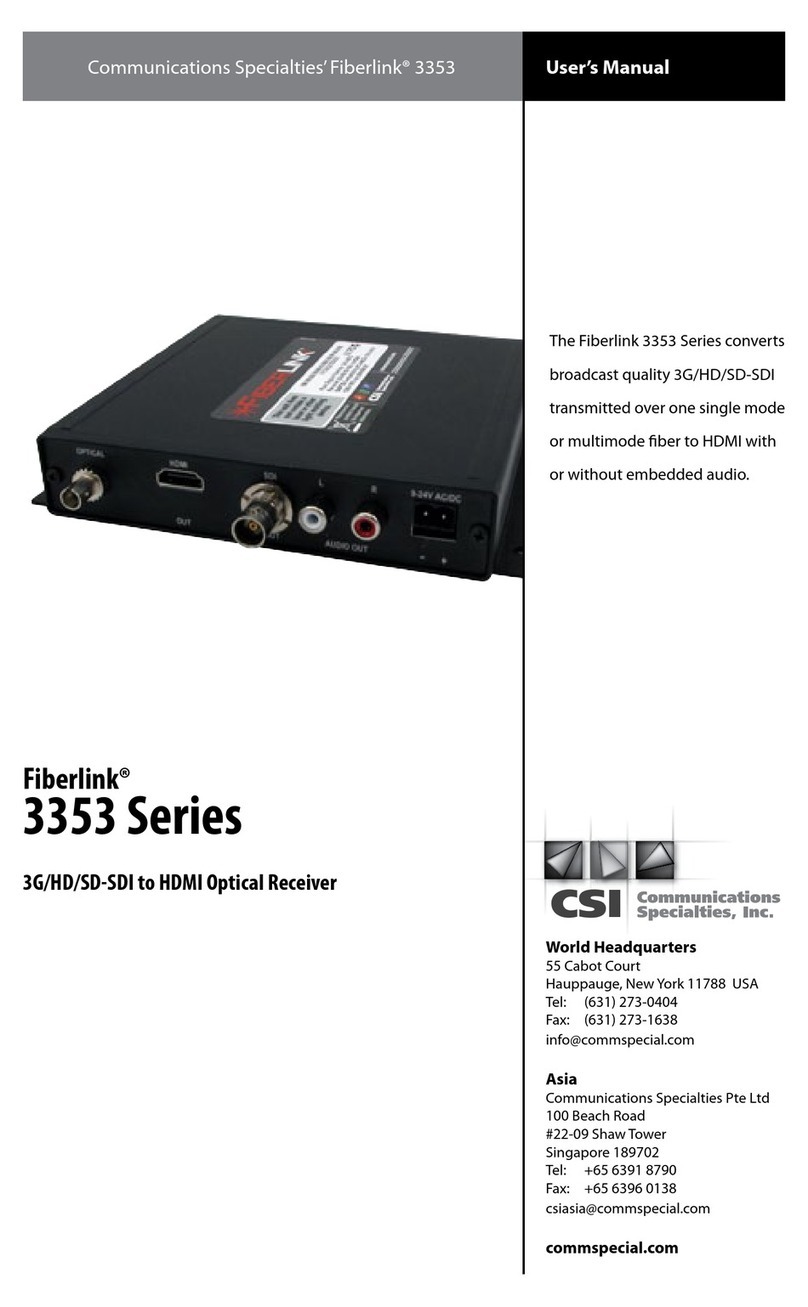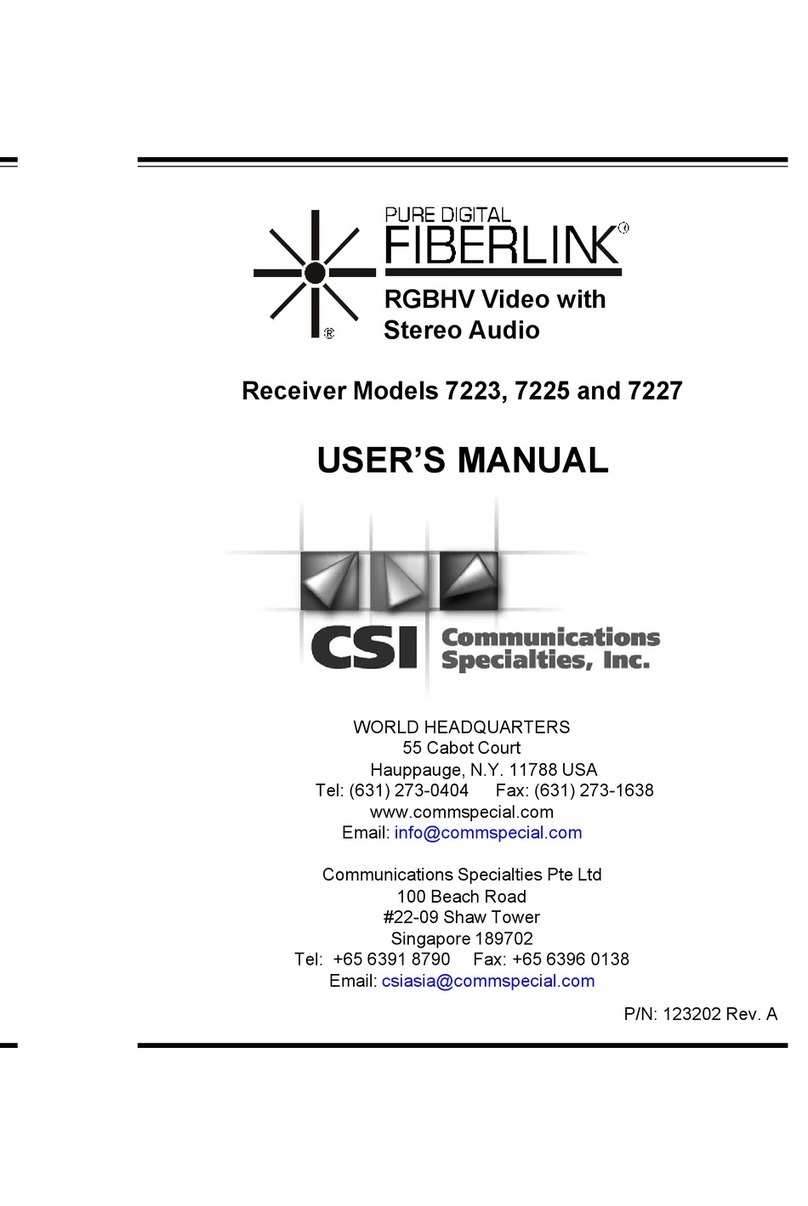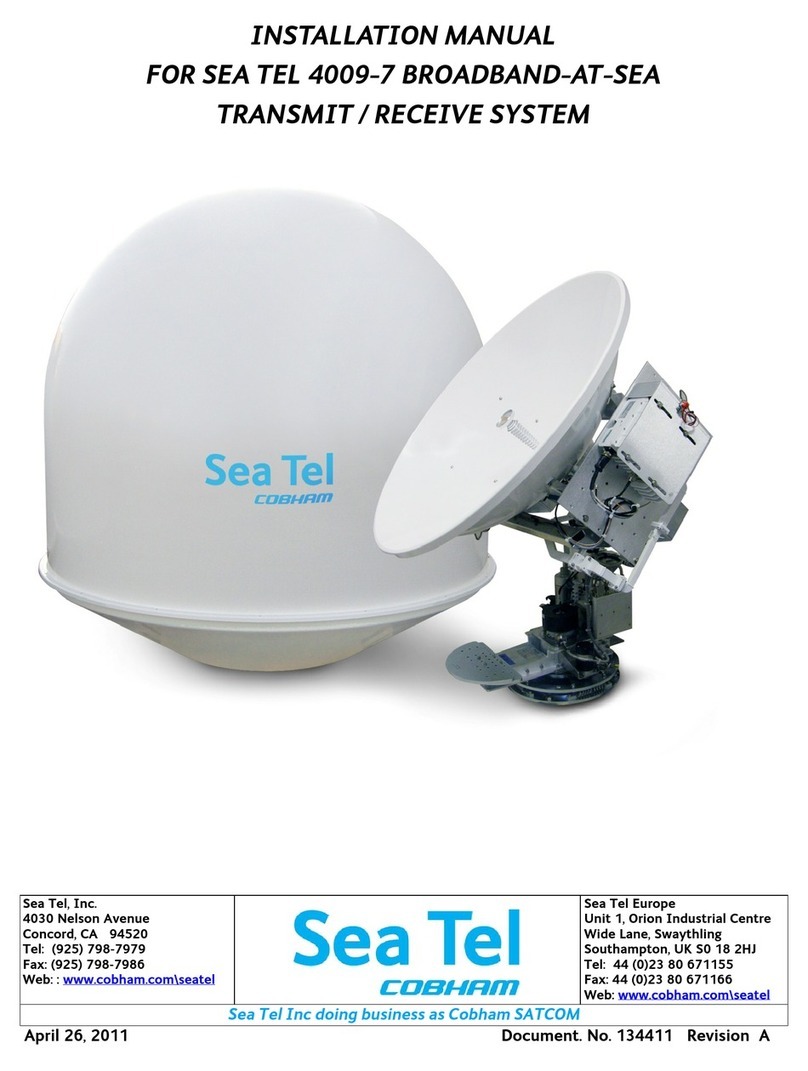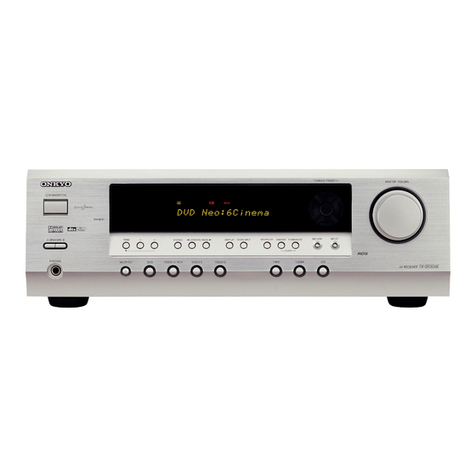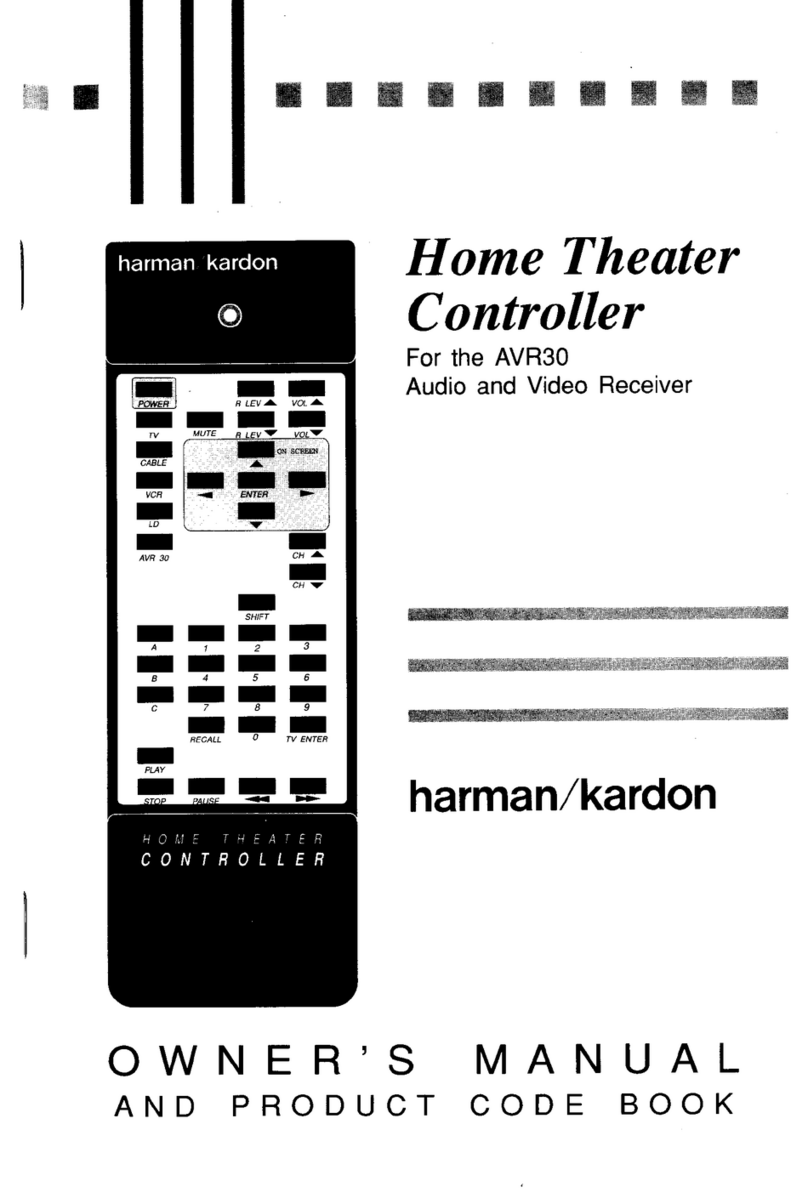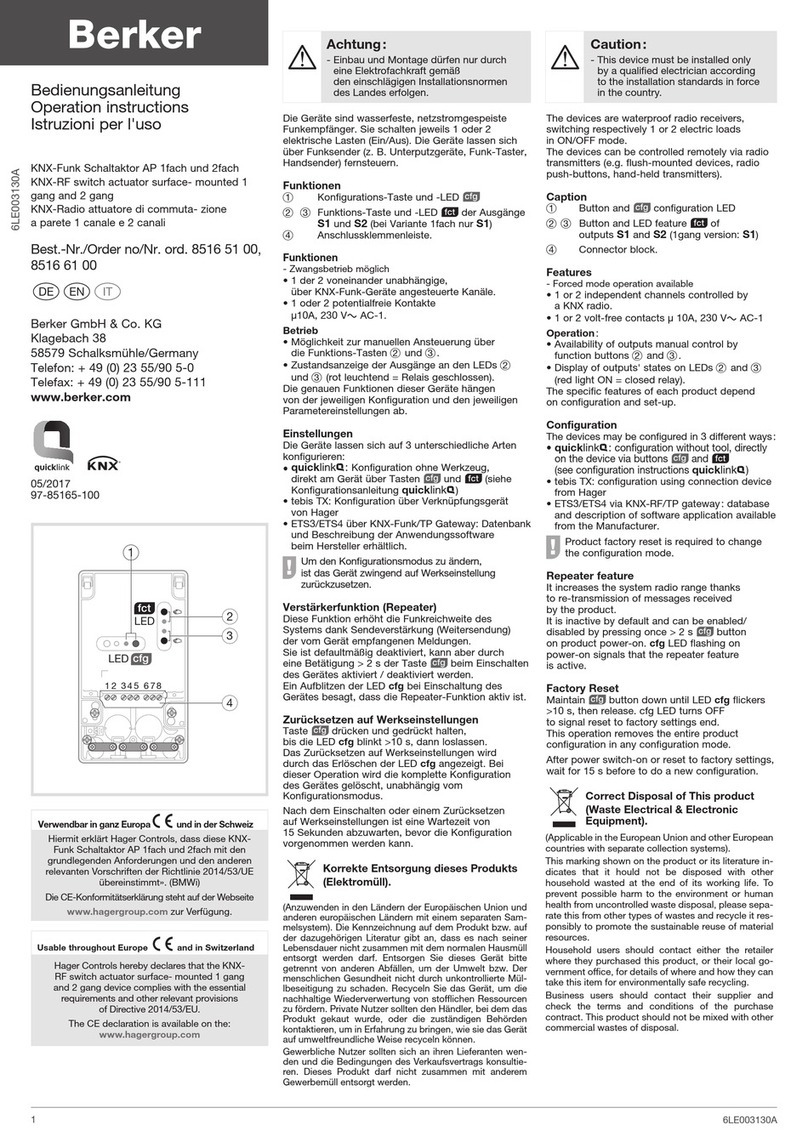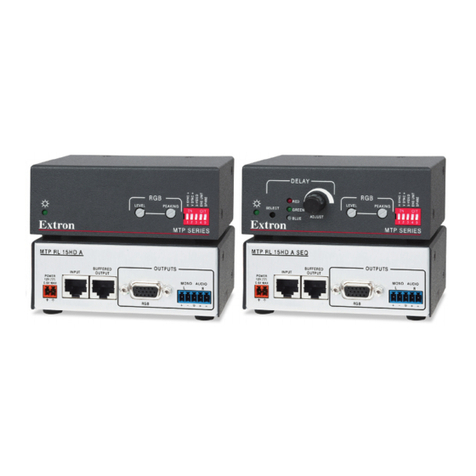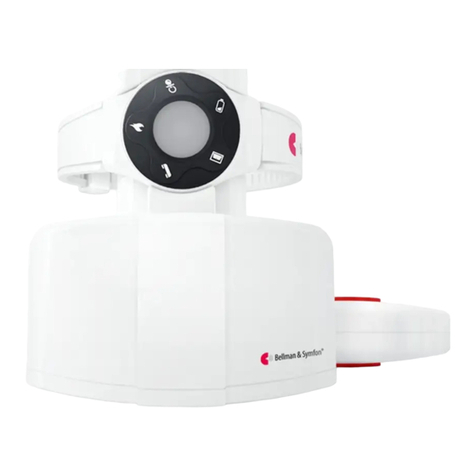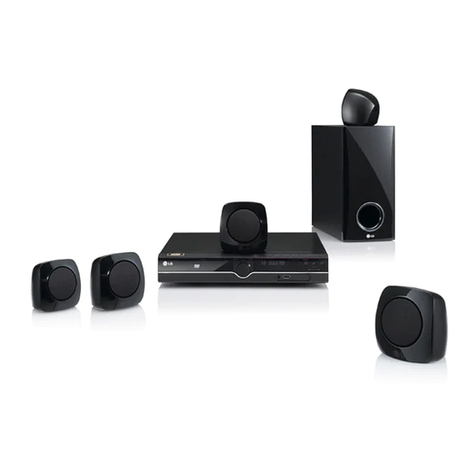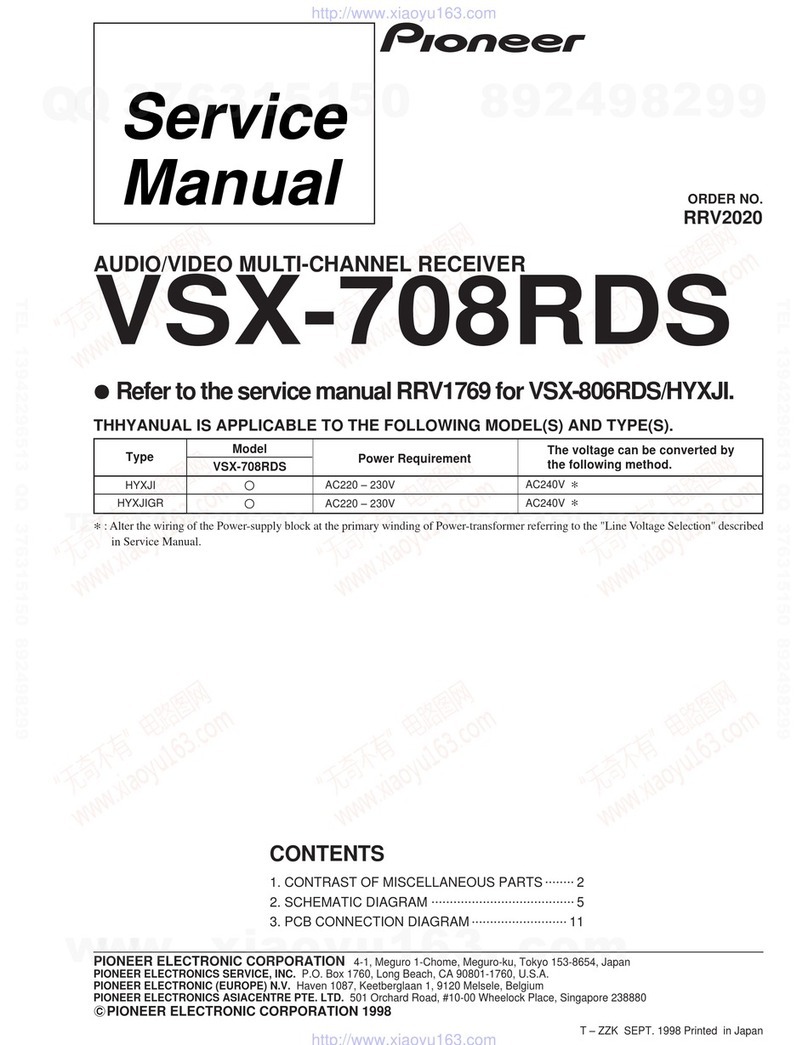Fiberlink 7220 User manual

USER’S MANUAL
P/N: 122995 Rev. D
Models 7220 and 7221
RGBHV Video with
Stereo Audio
WORLD HEADQUARTERS
55 Cabot Court
Hauppauge, N.Y. 11788 USA
Tel: (631) 273-0404 Fax: (631) 273-1638
www.commspecial.com
Email: [email protected]
Communications Specialties Pte Ltd
100 Beach Road
#22-09 Shaw Tower
Singapore 189702
Tel: +65 6391 8790 Fax: +65 6396 0138
Email: [email protected]

General Information ................................................... 3
Introduction ............................................................ 3
Technical Specifications ......................................... 3
Installation Instructions .............................................. 5
Installation Procedure ............................................. 6
System Connections ............................................... 6
Alarm Switch Settings ............................................ 7
Indicator LEDs and Alarm Circuitry ...................... 7
Operating Pointers and Troubleshooting ................... 9
Maintenance and Repairs ......................................... 10
Limited Warranty ..................................................... 11
CONTENTS
1

GENERAL INFORMATION
The Pure Digital Fiberlink®7220 Series is a transmitter/receiver pair
that transmits a single channel of RGBHV video and two audio chan-
nels over one single mode or multimode fiber. It is available as a free-
standing box unit or as a card version for use in the rackmountable
6000A card cage.
The system’s all digital encoding delivers noise-free transmissions
that retain all of their initial parameters, regardless of fiber optic cable
attenuation. System operation may be easily monitored using integral
indicator LEDs on each unit that continuously signify the presence of
baseband video and audio signals.
Introduction
Technical Specifications
Model Part Number Configurations:
Unit Type Part Number
Transmitter Box 7220-B7S
Transmitter Rack Card 7220-C7S
Receiver Box 7221-B7S
Receiver Rack Card 7221-C7S
All units transmit at
1310 nm wavelength
over single mode or
multimode fiber. ST
connectors are
provided.
Video:
Input Impedance ....................... RGB: 75 Ohms; H&V: Hi-Z
Input Level ............................... RGB: 714 mV p-p; H&V: 3 to 5 V p-p
H Sync Frequency Range ......... 31.5 to 60 kHz
V Sync Frequency Range ......... 30 to 85 Hz
Number of Video Channels ...... 1 RGBHV
RGB Format Supported ............ RGB with separate H and V
3
MAINTENANCE AND REPAIRS
The Pure Digital Fiberlink®7220 Series transmission units have been
manufactured using the latest semiconductor devices and techniques
that electronic technology has to offer. They have been designed for
long, reliable and trouble-free service and are not normally field repair-
able. Should difficulty be encountered, Communications Specialties
maintains a complete service facility to render accurate, timely and re-
liable service of all products.
The only maintenance that can be provided by the user is to ascertain
that the optical connectors are free of dust or dirt that could interfere
with light transmission and that electrical connections are secure and
accurate. DANGER! Always disconnect the transmitter power before
removing the optical fiber from the unit!
All other questions or comments should be directed to our Customer
Service Department. It should be noted that many “problems” can eas-
ily be solved by a simple phone call.
10
The status of the VIDEO and AUDIO indicator LEDs should provide
the first clue as to the origin of an operational failure. If these are off, it
usually means that the fiber is broken or has too much attenuation. Next,
be certain that the input and output signal connections are correct.
Finally, although multimode and single mode devices may look the
same, they will not operate properly together. Using the wrong device
or fiber can easily add more attenuation than specified, resulting in poor
overall performance.
If, after reviewing the above possibilities, the system is still not oper-
ating, please contact the Customer Service Department for further as-
sistance.

Miscellaneous:
Operating Temp. Range ........... -20 to +60 degrees C
Operating Power ...................... 9-24 Volts AC or DC@5 watts (max.)
4
Signal Connectors ................................ HD-15F
RGB Processing ................................... 24 bits, no compression or
scaling
Optical:
Operating Wavelength ......................... 1310 nm; MM or SM
Optical Fiber ........................................ 62.5/125 microns MM,
50/125 microns MM or
8-10/125 microns SM
Optical Connector ................................ ST
Class I Laser Product complies with FDA performance standard for
laser products, Title 21, Code of Federal Regulations, Sub-Chapter J
Audio:
Number of Audio Channels.................. 2, unbalanced
Frequency Response ............................. +0/-0.5 dB, 20 Hz to 20 kHz
Input Impedance ................................... >24 k Ohms
Output Impedance ................................ <1 Ohm
Maximum Audio Level ........................ +10 dBu
THD+N ................................................. 0.005%; 20 Hz - 20 kHz
SNR (A-Weighted) ............................... 95 dB
Channel Phase Differential ................... +/-0.1o
Crosstalk ............................................... Min. 95 dB (1 kHz)
Signal Connectors ................................ 3.5mm Stereo jack
Audio to Video Diff. Delay (skew) ..... <300 uS
OPERATING POINTERS AND TROUBLESHOOTING
Optical Fiber:
The 7220 Series is available in versions that operate with most mul-
timode (MM) and single mode (SM) optical fibers. Be certain that the
correct size fiber is being used for the particular transmitter/receiver
combination.
Also, remember to check the attenuation and bandwidth of the fiber
optic cable. The system will only operate properly if these specifica-
tions fall within the range of the system’s loss budget.
RECEIVER (continued):
Audio: OFF: Indicates no audio detected over fiber and, as a result,
no active audio detected by the receiver unit.
BLINKING: Indicates audio detected over fiber and, as a
result, active audio detected by the receiver unit.
Alarm: ON: Loss of video or optical signal (rack card only).
Troubleshooting:
Multimode fiber optic cable contains an optical fiber with a light
carrying “core” that is only .0025 inches (62.5 microns) in diameter.
Single mode fiber optic cable has an even smaller “core,” only .00032
to .0004 inches (8-10 microns). This is smaller than a human hair! There-
fore, any minute particles of dirt or dust can easily block the fiber from
accepting or radiating light. To prevent this from happening, always
use the provided dust caps whenever optical connectors are exposed to
air. It is also a good idea to gently clean the tip of an optical connector
with a lint-free cloth moistened with alcohol whenever dust is suspected.
9

5
DANGER! The transmitting element in the Pure Digital Fiberlink 7220 transmit-
ter unit contains a solid state Laser Diode located within the optical connector.
This device emits invisible infrared electromagnetic radiation which can be
harmful to human eyes. The radiation from this optical connector, if viewed at
close range without a fiber optic cable connected to the optical connector, may
be of sufficient intensity to cause instantaneous damage to the retina of the
eye. Direct viewing of this radiation should be avoided at all times.
INSTALLATION INSTRUCTIONS
Installation Procedure:
The Pure Digital Fiberlink®7220 Series transmission systems are
ready for immediate use. There are indicator LEDs on the units for moni-
toring purposes. The following instructions describe the typical instal-
lation procedure and the function of the LED indicators.
1. Connect the video source to the video input HD-15F connector on
the transmitter unit.
2. Connect the video output on the receiver unit to the HD-15F connector.
3. Connect the fiber optic cable between the two Pure Digital Fiberlink
units.
4. Connect the audio input signals to the transmitter stereo jack and the
audio output to the receiver stereo jack.
Loss Budget and Maximum Transmission Distance:
Wavelength Loss Budget (in dB) Distance* (in km)
1310 MM 0-15 0-0.75
1310 SM 0-15 0-35
*Distance specifications are only approximate and are not
guaranteed. Operating loss budget must not be exceeded.
8
TRANSMITTER and RECEIVER:
Power: ON: (GREEN) Indicates that correct power has been applied.
TRANSMITTER:
Video: OFF: Indicates no video detected on the input.
BLINKING GREEN: Indicates either H or V sync detected at
the input but not both.
STEADY GREEN: Indicates both H and V sync detected on
the input.
Audio: OFF: Indicates no audio detected on the transmitter unit.
BLINKING: Indicates audio detected on the transmitter unit.
Alarm: ON: Loss of video (rack card only)
RECEIVER:
Video: OFF: Indicates no video detected over fiber and, as a result,
no video present on the output.
BLINKING GREEN: Indicates either H or V sync detected
over the fiber but not both.
STEADY GREEN: Indicates both H and V sync detected
over fiber and, as a result, video present on the output.
provides an output to drive a model 6020 Alarm Sensing Module which
provides an audible tone and activates a set of contacts for external
signaling purposes.
The status of the LEDs are as follows:

6
5. Apply power to both Pure Digital
Fiberlink®units. For box versions
using DC power connections, refer to
Figure 1.
6. When power is applied, the green
POWER LED will light, indicating
the presence of operating power. The VIDEO LED will give an indica-
tion as described on Page 8.
7. The green AUDIO LED will give an indication as stated on
Page 8.
8. The system should now be operational.
Note that the rack card version has an additional red LED for indicat-
ing the presence of an alarm condition (loss of signal). Refer to the
table on the following page for alarm enables.
System Connections:
The input and output connections for the Pure Digital Fiberlink®
7220 Series system are as follows:
Audio Connector (Transmitter & Receiver): 3.5mm stereo jack
Video Connector (Transmitter & Receiver): HD-15F connector
Video Pin Out: Transmitter Receiver
1 Red Red
2 Green Green
3 Blue Blue
4 N/C N/C
5 Ground Ground
6 Ground Ground
7 Ground Ground
7
System Connections - “Video Pin Out” continued:
Video Pin Outs: Transmitter Receiver
8 Ground Ground
9 N/C N/C
10 Ground Ground
11 N/C N/C
12 N/C N/C
13 Hor. Sync. In Hor. Sync Out
14 Vert. Sync In Vert. Sync Out
15 N/C N/C
Indicator LEDs and Alarm Circuitry:
The stand-alone box version of the Pure Digital Fiberlink®7220
Series transmission unit has three integral indicator LEDs that are used
to monitor the state of the unit.
The rack card version of this product has an additional red indicator
LED that lights when an alarm condition exists. The rack card unit also
Note: “Loss of Video” refers to either loss of horizontal or vertical
sync. “Loss of Signal” refers to the absence of an optical signal.
Alarm Switch Settings (Transmitter; Card Version Only):
Switch Position Alarm Indication On Off
1 Loss of Video Enabled Disabled
2 N/A N/A N/A
Alarm Switch Settings (Receiver; Card Version Only):
Switch Position Alarm Indication On Off
1 Loss of Signal Enabled Disabled
2 Loss of Video Enabled Disabled

6
5. Apply power to both Pure Digital
Fiberlink®units. For box versions
using DC power connections, refer to
Figure 1.
6. When power is applied, the green
POWER LED will light, indicating
the presence of operating power. The VIDEO LED will give an indica-
tion as described on Page 8.
7. The green AUDIO LED will give an indication as stated on
Page 8.
8. The system should now be operational.
Note that the rack card version has an additional red LED for indicat-
ing the presence of an alarm condition (loss of signal). Refer to the
table on the following page for alarm enables.
System Connections:
The input and output connections for the Pure Digital Fiberlink®
7220 Series system are as follows:
Audio Connector (Transmitter & Receiver): 3.5mm stereo jack
Video Connector (Transmitter & Receiver): HD-15F connector
Video Pin Out: Transmitter Receiver
1 Red Red
2 Green Green
3 Blue Blue
4 N/C N/C
5 Ground Ground
6 Ground Ground
7 Ground Ground
7
System Connections - “Video Pin Out” continued:
Video Pin Outs: Transmitter Receiver
8 Ground Ground
9 N/C N/C
10 Ground Ground
11 N/C N/C
12 N/C N/C
13 Hor. Sync. In Hor. Sync Out
14 Vert. Sync In Vert. Sync Out
15 N/C N/C
Indicator LEDs and Alarm Circuitry:
The stand-alone box version of the Pure Digital Fiberlink®7220
Series transmission unit has three integral indicator LEDs that are used
to monitor the state of the unit.
The rack card version of this product has an additional red indicator
LED that lights when an alarm condition exists. The rack card unit also
Note: “Loss of Video” refers to either loss of horizontal or vertical
sync. “Loss of Signal” refers to the absence of an optical signal.
Alarm Switch Settings (Transmitter; Card Version Only):
Switch Position Alarm Indication On Off
1 Loss of Video Enabled Disabled
2 N/A N/A N/A
Alarm Switch Settings (Receiver; Card Version Only):
Switch Position Alarm Indication On Off
1 Loss of Signal Enabled Disabled
2 Loss of Video Enabled Disabled

5
DANGER! The transmitting element in the Pure Digital Fiberlink 7220 transmit-
ter unit contains a solid state Laser Diode located within the optical connector.
This device emits invisible infrared electromagnetic radiation which can be
harmful to human eyes. The radiation from this optical connector, if viewed at
close range without a fiber optic cable connected to the optical connector, may
be of sufficient intensity to cause instantaneous damage to the retina of the
eye. Direct viewing of this radiation should be avoided at all times.
INSTALLATION INSTRUCTIONS
Installation Procedure:
The Pure Digital Fiberlink®7220 Series transmission systems are
ready for immediate use. There are indicator LEDs on the units for moni-
toring purposes. The following instructions describe the typical instal-
lation procedure and the function of the LED indicators.
1. Connect the video source to the video input HD-15F connector on
the transmitter unit.
2. Connect the video output on the receiver unit to the HD-15F connector.
3. Connect the fiber optic cable between the two Pure Digital Fiberlink
units.
4. Connect the audio input signals to the transmitter stereo jack and the
audio output to the receiver stereo jack.
Loss Budget and Maximum Transmission Distance:
Wavelength Loss Budget (in dB) Distance* (in km)
1310 MM 0-15 0-0.75
1310 SM 0-15 0-35
*Distance specifications are only approximate and are not
guaranteed. Operating loss budget must not be exceeded.
8
TRANSMITTER and RECEIVER:
Power: ON: (GREEN) Indicates that correct power has been applied.
TRANSMITTER:
Video: OFF: Indicates no video detected on the input.
BLINKING GREEN: Indicates either H or V sync detected at
the input but not both.
STEADY GREEN: Indicates both H and V sync detected on
the input.
Audio: OFF: Indicates no audio detected on the transmitter unit.
BLINKING: Indicates audio detected on the transmitter unit.
Alarm: ON: Loss of video (rack card only)
RECEIVER:
Video: OFF: Indicates no video detected over fiber and, as a result,
no video present on the output.
BLINKING GREEN: Indicates either H or V sync detected
over the fiber but not both.
STEADY GREEN: Indicates both H and V sync detected
over fiber and, as a result, video present on the output.
provides an output to drive a model 6020 Alarm Sensing Module which
provides an audible tone and activates a set of contacts for external
signaling purposes.
The status of the LEDs are as follows:

Miscellaneous:
Operating Temp. Range ........... -20 to +60 degrees C
Operating Power ...................... 9-24 Volts AC or DC@5 watts (max.)
4
Signal Connectors ................................ HD-15F
RGB Processing ................................... 24 bits, no compression or
scaling
Optical:
Operating Wavelength ......................... 1310 nm; MM or SM
Optical Fiber ........................................ 62.5/125 microns MM,
50/125 microns MM or
8-10/125 microns SM
Optical Connector ................................ ST
Class I Laser Product complies with FDA performance standard for
laser products, Title 21, Code of Federal Regulations, Sub-Chapter J
Audio:
Number of Audio Channels.................. 2, unbalanced
Frequency Response ............................. +0/-0.5 dB, 20 Hz to 20 kHz
Input Impedance ................................... >24 k Ohms
Output Impedance ................................ <1 Ohm
Maximum Audio Level ........................ +10 dBu
THD+N ................................................. 0.005%; 20 Hz - 20 kHz
SNR (A-Weighted) ............................... 95 dB
Channel Phase Differential ................... +/-0.1o
Crosstalk ............................................... Min. 95 dB (1 kHz)
Signal Connectors ................................ 3.5mm Stereo jack
Audio to Video Diff. Delay (skew) ..... <300 uS
OPERATING POINTERS AND TROUBLESHOOTING
Optical Fiber:
The 7220 Series is available in versions that operate with most mul-
timode (MM) and single mode (SM) optical fibers. Be certain that the
correct size fiber is being used for the particular transmitter/receiver
combination.
Also, remember to check the attenuation and bandwidth of the fiber
optic cable. The system will only operate properly if these specifica-
tions fall within the range of the system’s loss budget.
RECEIVER (continued):
Audio: OFF: Indicates no audio detected over fiber and, as a result,
no active audio detected by the receiver unit.
BLINKING: Indicates audio detected over fiber and, as a
result, active audio detected by the receiver unit.
Alarm: ON: Loss of video or optical signal (rack card only).
Troubleshooting:
Multimode fiber optic cable contains an optical fiber with a light
carrying “core” that is only .0025 inches (62.5 microns) in diameter.
Single mode fiber optic cable has an even smaller “core,” only .00032
to .0004 inches (8-10 microns). This is smaller than a human hair! There-
fore, any minute particles of dirt or dust can easily block the fiber from
accepting or radiating light. To prevent this from happening, always
use the provided dust caps whenever optical connectors are exposed to
air. It is also a good idea to gently clean the tip of an optical connector
with a lint-free cloth moistened with alcohol whenever dust is suspected.
9

GENERAL INFORMATION
The Pure Digital Fiberlink®7220 Series is a transmitter/receiver pair
that transmits a single channel of RGBHV video and two audio chan-
nels over one single mode or multimode fiber. It is available as a free-
standing box unit or as a card version for use in the rackmountable
6000A card cage.
The system’s all digital encoding delivers noise-free transmissions
that retain all of their initial parameters, regardless of fiber optic cable
attenuation. System operation may be easily monitored using integral
indicator LEDs on each unit that continuously signify the presence of
baseband video and audio signals.
Introduction
Technical Specifications
Model Part Number Configurations:
Unit Type Part Number
Transmitter Box 7220-B7S
Transmitter Rack Card 7220-C7S
Receiver Box 7221-B7S
Receiver Rack Card 7221-C7S
All units transmit at
1310 nm wavelength
over single mode or
multimode fiber. ST
connectors are
provided.
Video:
Input Impedance ....................... RGB: 75 Ohms; H&V: Hi-Z
Input Level ............................... RGB: 714 mV p-p; H&V: 3 to 5 V p-p
H Sync Frequency Range ......... 31.5 to 60 kHz
V Sync Frequency Range ......... 30 to 85 Hz
Number of Video Channels ...... 1 RGBHV
RGB Format Supported ............ RGB with separate H and V
3
MAINTENANCE AND REPAIRS
The Pure Digital Fiberlink®7220 Series transmission units have been
manufactured using the latest semiconductor devices and techniques
that electronic technology has to offer. They have been designed for
long, reliable and trouble-free service and are not normally field repair-
able. Should difficulty be encountered, Communications Specialties
maintains a complete service facility to render accurate, timely and re-
liable service of all products.
The only maintenance that can be provided by the user is to ascertain
that the optical connectors are free of dust or dirt that could interfere
with light transmission and that electrical connections are secure and
accurate. DANGER! Always disconnect the transmitter power before
removing the optical fiber from the unit!
All other questions or comments should be directed to our Customer
Service Department. It should be noted that many “problems” can eas-
ily be solved by a simple phone call.
10
The status of the VIDEO and AUDIO indicator LEDs should provide
the first clue as to the origin of an operational failure. If these are off, it
usually means that the fiber is broken or has too much attenuation. Next,
be certain that the input and output signal connections are correct.
Finally, although multimode and single mode devices may look the
same, they will not operate properly together. Using the wrong device
or fiber can easily add more attenuation than specified, resulting in poor
overall performance.
If, after reviewing the above possibilities, the system is still not oper-
ating, please contact the Customer Service Department for further as-
sistance.

2
LIMITED WARRANTY
Communications Specialties, Inc. (CSI) warrants that for a period of
three years after purchase by the Buyer, the Pure Digital Fiberlink®
7220 Series transmission System will be free from defects in material
and workmanship under normal use and service. A Return Material Au-
thorization (RMA) number must be obtained from CSI before any equip-
ment is returned by the Buyer. CSI’s obligation under this warranty
will be limited, at its option, to either the repair or replacement of de-
fective units, including free materials and labor. In no event shall CSI
be responsible for any incidental or consequential damages or loss of
profits or goodwill. CSI shall not be obligated to replace or repair equip-
ment that has been damaged by fire, war, acts of God, or similar causes,
or equipment that has been serviced by unauthorized personnel, altered,
improperly installed or abused.
RMA numbers and repairs can be obtained from:
Communications Specialties, Inc.
55 Cabot Court
Hauppauge, NY 11788 USA
Tel: (631) 273-0404 Fax: (631) 273-1638
Or, in the Asia Pacific Region:
Communications Specialties Pte Ltd
100 Beach Road, #22-09 Shaw Tower
Singapore 189702
Tel: +65 6391 8790 Fax: +65 6396 0138
Email: [email protected]
Please have your serial number (located on the top label of the unit)
available with contacting us.
11
This manual suits for next models
1
Table of contents
Other Fiberlink Receiver manuals
